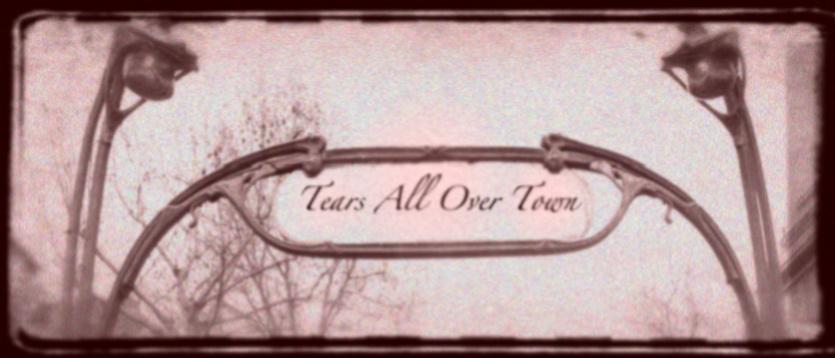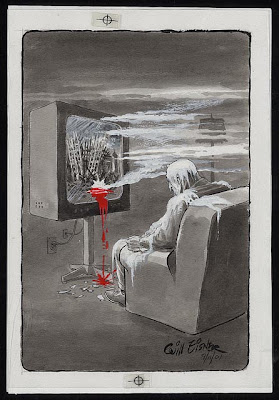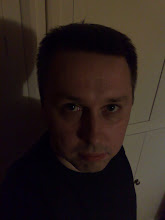
So where to start with Inland Empire, David Lynch's most recent headscratcher?
Hmm...OK, so like much of Lynch's recent output, Inland Empire is baffling, beautiful, hypnotic and frustrating, all at once. It begins for the first hour to make a sort of sense. Laura Dern plays a actress who takes on a new role in a movie that promises to boost her fading cache in Hollywood. She then learns that said movie is actually a remake of a Polish film that never got finished when the lead stars were killed.
After an hour of thinking, yep, I'm with you, I'm following this fine, I'm really gonna follow this Lynch movie, Inland Empire goes batshit crazy. I've read explanations of Lost Highway and Mulholland Drive, and upon returning to those movies, I can can sort of see the thread of (I'm reluctant to say) logic upon the repeated viweing. There are similar themes to those recent Lynch movies running through Inland Empire: the splitting of personalities/identities; the wilful use of dream logic and the repetition of events in different contexts. But that in mind, this movie defies exact definition. Like a dream, walls appear behind scene after scene, so that you're left with no clear way out of the maze. At times, Dern appears to be the character in the movie she's making; a whore, a battered wife, an actress, and even a time traveller of sorts. And similarly to Naomi Watt's character in Mulholland Drive, who travels to another self via a box midway through the film, Dern seems to be transported White Rabbit-like through a cigarette burned hole in some silk underwear. There's a sit-com with three figures with rabbit heads (which again implies that White Rabbit theory), the usual Lynchinan tropes and motifs of guttering electricity, strobing lights and bizarre characters speaking portentous nonsense, and his ability (like no other)to make an otherwise prosaic American front room simply reek with dread. There's also a posse of LA prostitutes who at one point do a line-dance to The Locomotion (and rather well, I might add), some Polish trafficking characters, and the sense that as a viewer, you are part of the mystery - there are certain points where characters turn to the screen implying that something is expected of you.
After having a post-viewing look on various sites that try to tease apart the conundrum of Inland Empire, I can see glimpses of what appear to be a fairly cogent explanation, but I think part of the charm of Lynch is that it's all subjective and it's not all supposed to make sense. The journey is more important than the destination.
So, Inland Empire. Did I like it? Yes. I think I was more prepared for what was to unfold after the (now realtively straight-forward) narrative twists of Mulholland Drive and Lost Highway. It's a little too long, but I can forgive Lynch the indulgence of it for the basic fact that there is no-one who makes movies like this. He is utterly unique, a trailblazer, and to be celebrated for the fact. Inland Empire is hypnotic, polyvalent, unsettling and maddening, and even if you find Lynch's lack of narrative cohesion frustrating, you have to keep going back to his movies, time after time for a reason you can't quite define.
It's also Lynch's first foray into the world of DV - shot on a Sony PD-150 and edited on Apple's Final Cut Pro. I'd thought that DV might undermine that lush sense of classic 35mm 'celluloid' that his previous movies have, but the crispness of the image manages to seem somehow more Lynchian, if anything.
So what's Inland Empire about? All of the above and a bit more besides. It's still running around in my head now, and I feel like I want to return to it at some point to unravel it some more. Which, I guess is as good a recommendation as anyone could give. But as one witty poster on a Guardian forum put it when asked what Inland Empire was about: '...three hours. And one hour too many.
 RIP John Martyn, who died yesterday. Although he was never a household name, he was one of the great guitar innovators. Solid Air, his most famous album is one of those albums you need with you if you were on a desert island. Every track is magnificent, and sounds utterly sublime, particularly on vinyl.
RIP John Martyn, who died yesterday. Although he was never a household name, he was one of the great guitar innovators. Solid Air, his most famous album is one of those albums you need with you if you were on a desert island. Every track is magnificent, and sounds utterly sublime, particularly on vinyl.




 By the mid-twenties, countless New York skyscrapers were queued up to be bathed in Ferriss's moody draftmanship. The city was transformed into a dramatic chiaroscuro, the buildings massed in shadow and fog, lit and obscured by roaming spotlights; the structures themselves almost overwhelmingly gigantic, like the houses of gods.
By the mid-twenties, countless New York skyscrapers were queued up to be bathed in Ferriss's moody draftmanship. The city was transformed into a dramatic chiaroscuro, the buildings massed in shadow and fog, lit and obscured by roaming spotlights; the structures themselves almost overwhelmingly gigantic, like the houses of gods. Ferriss intended his work as an example to other architects that they would put concept, human experience and emotional response before capitalistic concerns. What he also did was create a visual language to understand the potential of skyscrapers. Look at Batman's Gotham City or the recent Sky Captain and The World of Tomorrow to see the effect that Ferriss still has in popular culture. The art really speaks for itself. It's staggeringly beautiful. All cities should look like this...
Ferriss intended his work as an example to other architects that they would put concept, human experience and emotional response before capitalistic concerns. What he also did was create a visual language to understand the potential of skyscrapers. Look at Batman's Gotham City or the recent Sky Captain and The World of Tomorrow to see the effect that Ferriss still has in popular culture. The art really speaks for itself. It's staggeringly beautiful. All cities should look like this...






 Then, not four months later Cole one morning drove to a store and bought a .22 pistol. He mailed two letters, one to his wife and one to Hefner, then drove to a secluded spot and shot himself in the head. The two letters were effectively suicide notes, and neither were made available to the public, although his wife testified that 'Jack had given his reasons.'
Then, not four months later Cole one morning drove to a store and bought a .22 pistol. He mailed two letters, one to his wife and one to Hefner, then drove to a secluded spot and shot himself in the head. The two letters were effectively suicide notes, and neither were made available to the public, although his wife testified that 'Jack had given his reasons.'





































